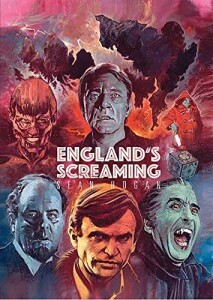 Sean Hogan’s England’s Screaming is an interesting piece of literary studies as fiction. Specifically, it takes a number of icons and figures from British horror and attempts to build a coherent timeline of events assuming they occupy a united world. This is a fascinating idea, harkening back to David Thompson’s Suspects (a fact which Hogan makes clear in his own preface) or Philip Jose Farmer’s World Newton ideas, although done with different style and organization.
Sean Hogan’s England’s Screaming is an interesting piece of literary studies as fiction. Specifically, it takes a number of icons and figures from British horror and attempts to build a coherent timeline of events assuming they occupy a united world. This is a fascinating idea, harkening back to David Thompson’s Suspects (a fact which Hogan makes clear in his own preface) or Philip Jose Farmer’s World Newton ideas, although done with different style and organization.
The volume organizes itself with individual sections which manage to hold themselves together through small connections to the others. These are mostly side details, offhand references or a lead of one story as a bit part in another. Yet the little threads of connection weave well, creating references obscure and obvious which build into a surprisingly effective whole. There are little side plots which are fascinating, horrifying, and depressing. Little notes related to a major character in one story will appear throughout others, and the strange figures will make their returns when an unfamiliar reader might least suspect.
Many threads are left dangling, or at least ambiguous, yet in a world of the strange and horrific that is indeed appropriate. A few sections seem completely disconnected from the rest of the narrative at first glance, as many of the references are subtle and the stories began fairly independently.
An oddity of this book ss that images of each character are placed at the beginning of their chapters. This means that not only do we see multiple actors images for Damien Thorn, but also that the countenance of Christopher Lee faces the reader in a number of different guises. It is amusing, yet might undermine the horror elements ever so slightly.
A list of films and works referenced comes towards the back; however, at least a few (like The Children of the Damned/The Midwich Cuckoo’s) are referenced in the book but not listed, truly a rather strange decision. As I have not seen every horror film made, it leaves me wondering what other sources have gone unlisted.
The section on Hugo Finch makes the claim he was also Fats from William Goldman’s Magic, an entertaining claim to be sure. This sort of canon-welding is amusing, although not necessarily ideal. However, this is not mentioned in the introductory material for Hugo Finch, despite the fact that the section on Lord Summerisle mentions another character the book purports him to be. The inconsistency is hardly appreciated, although the desire to keep surprises for a reader is understandable.
Overall England’s Screaming is an easy book to love for a fan of horror, and a fan of a particular subset of British horror even more so. It manages to read as something of a chilling secret history, an alternate little world that while not entirely public and understood is clearly filled with disturbing supernatural elements. Heartily recommended to fans of the genre, and fans of the esoteric alternate history.
(PS Publishing, 2020)
